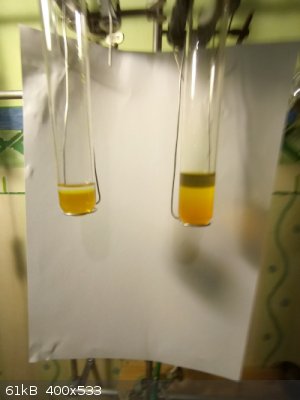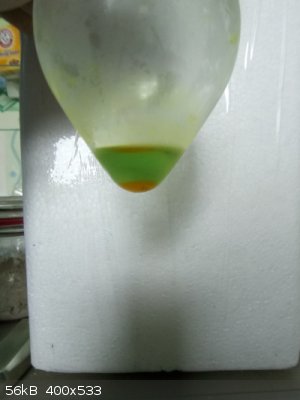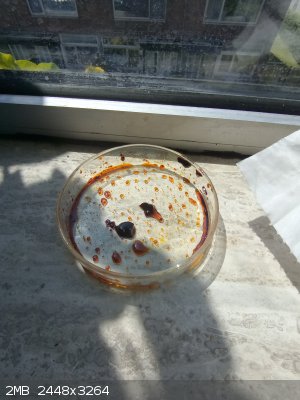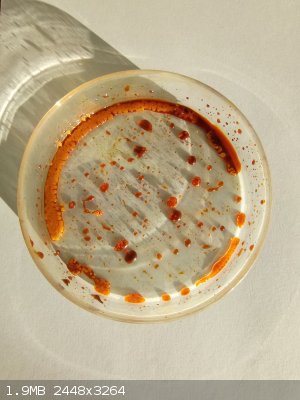| Pages:
1
2
3 |
DraconicAcid
International Hazard
    
Posts: 4339
Registered: 1-2-2013
Location: The tiniest college campus ever....
Member Is Offline
Mood: Semi-victorious.
|
|
Dammit. I was all set to do a Friedels-Craft alkylation when I found out my ferric chloride is the hexahydrate. I'm pretty sure that won't work.
I can probably convert it to NBu4[FeCL4], but I doubt that will help.....
Please remember: "Filtrate" is not a verb.
Write up your lab reports the way your instructor wants them, not the way your ex-instructor wants them.
|
|
|
clearly_not_atara
International Hazard
    
Posts: 2793
Registered: 3-11-2013
Member Is Offline
Mood: Big
|
|
If you can make a dry tetrachloroferrate, you can probably pyrolyse it to obtain FeCl3, no?
|
|
|
DraconicAcid
International Hazard
    
Posts: 4339
Registered: 1-2-2013
Location: The tiniest college campus ever....
Member Is Offline
Mood: Semi-victorious.
|
|
Possibly.
It seems you can also extract H[FeCl4] into ether or some other organic solvents. I might try that.
Please remember: "Filtrate" is not a verb.
Write up your lab reports the way your instructor wants them, not the way your ex-instructor wants them.
|
|
|
j_sum1
|
Thread Pruned
22-7-2018 at 16:54 |
DraconicAcid
International Hazard
    
Posts: 4339
Registered: 1-2-2013
Location: The tiniest college campus ever....
Member Is Offline
Mood: Semi-victorious.
|
|
I checked the storeroom at the other campus, and lo and behold! two bottles of anhydrous ferric chloride! According to the label, though...one of
them was 20% full of a dark liquid that sloshed around when I picked it up, and very little solid at all.
Please remember: "Filtrate" is not a verb.
Write up your lab reports the way your instructor wants them, not the way your ex-instructor wants them.
|
|
|
JJay
International Hazard
    
Posts: 3440
Registered: 15-10-2015
Member Is Offline
|
|
I have a large unopened jar of ferric chloride. I'd be interested in seeing details on your alkylation.
|
|
|
clearly_not_atara
International Hazard
    
Posts: 2793
Registered: 3-11-2013
Member Is Offline
Mood: Big
|
|
https://pubs.acs.org/doi/abs/10.1021/ac60202a040?journalCode...
I was very surprised to find that tetrachloroferrate salts "may be dried at 110 C in air without decomposition", and can be prepared from the simplest
starting materials: tetramethylammonium chloride and FeCl3 hexahydrate.
[Edited on 26-7-2018 by clearly_not_atara]
|
|
|
clearly_not_atara
International Hazard
    
Posts: 2793
Registered: 3-11-2013
Member Is Offline
Mood: Big
|
|
Can't edit the above post. I think this is the paper you wanted.
https://www.researchgate.net/publication/231427245_The_Extra...
Attachment: laurene1955.pdf (580kB)
This file has been downloaded 593 times
|
|
|
MidLifeChemist
Hazard to Others
  
Posts: 192
Registered: 4-7-2019
Location: West Coast USA
Member Is Offline
Mood: precipitatory
|
|
I received a 1lb (454g) "brick" of Iron (III) Chloride from US Pigments.
It would not break, it was rock hard. Covered with layers of newspaper and saran wrap. I donned my nitrile gloves and started to unwrap the saran
wrap.
This brick was rock-hard, and wouldn't even fit into my 1000ml beaker, remaining lodged at the top of the beaker. However, after a few squirts of
distilled water, the edges dissolved and the brick slid down to the bottom of the beaker. I added a couple hundred more milliliters of distilled
water, and the solution got very, very hot and was an intense red-brown color. Also, I noticed that this "brick" stains everything around it a
brownish-yellow color, even things it doesn't touch (half joking here).
So that was last night. I'm not sure what I'm going to do with it. The beaker is sitting there with 300ml of water in it, and some size chunk of
undissolved FeCl3. The way I see it, I have 2 choices:
#1 Add more water until it all dissolves, store it as a concentrated FeCL3 solution is a couple of 16oz HDPE bottles that I have laying around...
#2 - Heat the solution until it all dissolves, and try to recrystalize it in a large glass tray and a fan like NileRed did. I realize will be
difficult as FeCL3 is very hygroscopic and may take several days. and I don't have a dedicated rented lab like NileRed does, I have a house with a
garage and kids.
I'm open to suggestions from my fellow ScienceMadness members!
|
|
|
teodor
National Hazard
   
Posts: 905
Registered: 28-6-2019
Location: Netherlands
Member Is Offline
|
|
Sorry, this is response to 2 years old post, but I found it by google few days ago and something made me interested.
Quote: Originally posted by woelen  | | The reason that no FeCl3 from aqueous solution is extracted into an organic layer is due to the ionic nature of the hydrated compound in solution.
|
I did a few experiment with diethyl ether extraction. As a starting material I used freshly precipitated Fe(OH)3 solution in 36% HCl (the full amount
of Fe(OH)3 which could be dissolved). So, my initial solution of FeCl3 as I suppose didn't contain anything else except FeCl3 and water.
I red the extraction of FeCl3 from water solution is possible when we have it 6M in HCl.
Just to compare: the ether layer of initial FeCl3 (without HCl) and the same solution + HCl to make it 6M:

(the resolution is not enough to see but I can say the ether layer at the left is totally white).
Then I made some pictures that shows colour of ether layer depending on HCl aqueous solution molarity (at the right it is always 6M):
    
Of course it doesn't mean it is easy to extract solid from that ether - as we know ether always dissolves a bit of water and I am not sure whether HCl
can change (let say, increase) this amount but I think it could.
Also I tested a bit the FeCl3 affinity to water (in organic solvents) and it is really bigger than few compounds I tried to use to dehydration.
But it shows that, possible, with displacing OH ligands with Cl the property of FeCl3 are changing from ionic to more covalent, if woelen's theory is
true.

Edit:
The colour of FeCl3 0M in HCl and FeCl3 6M in HCl is completely different, but after first shaking it becomes almost equal, so I think it is either
because the ether layer gets that HCl from water or it lowers the concentration of FeCl3.

Also you can see here at the right 3 distinct layer: ether, FeCl3 in contact with ether almost discolored (the same color as ether) and the initial
FeCl3 concentration in the bottom layer.
[Edited on 13-10-2020 by teodor]
[Edited on 13-10-2020 by teodor]
[Edited on 13-10-2020 by teodor]
[Edited on 13-10-2020 by teodor]
|
|
|
Texium
Administrator
       
Posts: 4593
Registered: 11-1-2014
Location: Salt Lake City
Member Is Offline
Mood: PhD candidate!
|
|
Nice experiment, teodor. I suppose that what you're extracting into the ether layer is essentially "tetrachloroferric acid," H+
[FeCl4]- which you could expect to be a little more soluble in organic solvent than what is essentially a mixture of hydrated
ferric ions and chloride ions.
Honestly, I know it's not going to catch on, but I think the anhydrous forms of ferric chloride, aluminum chloride, zinc chloride, etc, shouldn't even
be thought of as different versions of the same compound as their hydrous forms. When you consider the difference in structure and chemical
properties, it's practically as inaccurate as calling acetic anhydride "anhydrous acetic acid." I propose the use of more covalent sounding names for
these covalent metal halides. How does trichloroiron sound?
|
|
|
teodor
National Hazard
   
Posts: 905
Registered: 28-6-2019
Location: Netherlands
Member Is Offline
|
|
Thank you Texium.
Indeed, in acc. with wikipedia:
FeCl3 * 6H2O has the structural formula trans-[Fe(H2O)4Cl2]Cl * 2H2O
FeCl3 * 2.5H2O has the structural formula cis-[Fe(H2O)4Cl2][FeCl4] * H2O.
FeCl3 * 2H2O has the structural formula trans-[Fe(H2O)4Cl2][FeCl4].
FeCl3 * 3.5H2O has the structural formula cis-[FeCl2(H2O)4][FeCl4] *3H2O.
So, I suppose the ether layer extracts H[FeCl4], the tetrahedral form and the water layer keeps the octahedral [Fe(H2O)4Cl2]2+ which then
disproportionates more upon addition of HCl, that way all the iron could be extracted to the ether layer (according to literature).
After standing overnight in a freezer the ether layer was separated into 2 layers. I think the lower one now collected most of the water by formation
of the octahedral form again. So, I suppose the upper layer is H[FeCl4].

It's amazing that this acid could be isolated as free acid solution (or is it Fe[FeCl4]3 ?).
If it is free acid, is it possible to make its ammonium salt? And what should be its decomposition product in anhydrous environment?
So, any information about [FeCl4]- acid is welcome.
Edit: Did somebody dissolve anhydrous FeCl3 in diethyl ether? Which color did you observe?
[Edited on 14-10-2020 by teodor]
[Edited on 14-10-2020 by teodor]
|
|
|
teodor
National Hazard
   
Posts: 905
Registered: 28-6-2019
Location: Netherlands
Member Is Offline
|
|
I did few experiments trying different organic solvents. I had idea that extraction ability is depending on the ability to dissolve HCl.
So, I found that n-butyl acetate has the same extraction properties as diethyl ether. Indeed, it has also good ability to dissolve HCl, so probably my
hypothesis is right.
Unlike diethyl ether n-butyl acetate takes virtually no water from FeCl3/HCl/H2O solution. So it is possible to dry the organic layer completely which
gives a yellow film on a glass. This film very fast changes the color from yellow to brown (several seconds), probably it is the action of oxygen. It
is not possible to dissolve brown ("oxydised") part of the film in water, but it seams yellow film could be dissolved immediately upon contact with
water.
I think it's worth trying to dry the solution in oxygen-free environment.
[Edited on 17-10-2020 by teodor]

|
|
|
ChemichaelRXN
Hazard to Others
  
Posts: 103
Registered: 7-10-2010
Member Is Offline
Mood: Universal Eye
|
|
What if you keep the beaker with the wet ferric chloride in a type of vacuum desiccator with heat somehow applied to the beaker with a heat strip
wrapping? I think that might drive the water out and keep it stored in the desiccant. It might take at least a few days possibly, but it may work.
You are the same perception looking out, from the same elements around the universe.
You are everything to be anything to begin with.
Https://you-are.space
Https://syntharise.com
|
|
|
teodor
National Hazard
   
Posts: 905
Registered: 28-6-2019
Location: Netherlands
Member Is Offline
|
|
Yes, I thought about that. Probably the vacuum pump will go up in my shopping list.
But today I think the real reason of "oxidation" is loosing HCl in the drying process. I am thinking about possibility to remove HCl from n-butyl
acetate solution without drying.
|
|
|
teodor
National Hazard
   
Posts: 905
Registered: 28-6-2019
Location: Netherlands
Member Is Offline
|
|
I did the experiment of FeBr3 extraction with ether and it was quite successful. Unlike FeCl3 or, more accurate to say, FeCl3 * n HCl * mH2O it is
quite easy to get some nice-looking crystals by evaporating ether a bit.
It is interesting that product of Fe(OH)3 reaction with HBr has dark-brown color, the same color as bromine itself. (Reaction of Fe(OH)3 with HCl
produces light-yellow color).
|
|
|
Fery
International Hazard
    
Posts: 1020
Registered: 27-8-2019
Location: Czechoslovakia
Member Is Offline
|
|
Teodor, nice experiments! I would be afraid of water present in diethylether as you already mentioned - I see you froze out as much H2O as possible in
freezer overnight in FeCl3 experiment. And very probably with FeBr3 too. Were your products completely water free? Your method is cool way of
preparing anhydrous compounds and avoids dangerous vigorous direct reaction of halogen with metal. I see you also used butylacetate which is more
water free than diethylether. Couldn't be also methylisobutylketone used? I know it is used for precious metal extractions (but as cyanides), perhaps
it could work with FeCl3/H[FeCl4]/FeBr3 too?
|
|
|
teodor
National Hazard
   
Posts: 905
Registered: 28-6-2019
Location: Netherlands
Member Is Offline
|
|
Thanks Fery.
In the case of FeCl3 the water goes together with H[FeCl4] molecules far beyond usual capacity of the organic layer, at least in case of ether. This
process was studied by Ernest H. Swift in various works, for example here: https://doi.org/10.1021/ja01303a058
I didn't find any study of other solvents, so my result with n-butyl acetate is quite interesting. As a next step I plan to measure water amount which
goes into organic layer as well as Fe, Cl. It is possible that water extraction is always proportional to Fe3+ extraction, so we either get water or
no Fe.
Edit: I doubt that freezing the water out (as on my picture) freeze all the water. But evaporation of ether on air is not quite accurate test for
that. But I didn't make more accurate measurement yet.
Also H[FeCl4] was never isolated as far as I know. But it is the same as make the products water free. So, I doubt it is easy. FeCl3 has bigger
affinity to water than many desiccants and I didn't find much information about H[FeCl4] without water, usually it forms H[FeCl4] * nH2O (according to
Swift).
I think I will give a try to AlCl3, SnCl4. Also have no idea about possible reaction with P2O5.
Edit: probably the easier is to test FeCl3 (anhydrous) solution in an absolute ether with different water-containing compounds.
I didn't study FeBr3 yet except one short experiment which immediately gave me some crystals from ether, probably FeBr3 * nH2O. But I already
mentioned the color difference, that probably means also the difference of the Fe complex ion itself.
About methylisobutylketone - good idea thanks. I will compare with n-butyl acetate if will put my hand on it.
[Edited on 7-12-2020 by teodor]
[Edited on 7-12-2020 by teodor]
|
|
|
Fery
International Hazard
    
Posts: 1020
Registered: 27-8-2019
Location: Czechoslovakia
Member Is Offline
|
|
Teodor, I have 5 L of that solvent. If you have any idea let me know.
Maybe trying to mix anhydrous FeCl3 in excess with solvent in stoppered vessel for few days, then decant the liquid, e.g. 2 ml into testing tube using
graduated pipette, the same with diethylether, n-butylacetate...
Then add 5 ml water solution of SCN- into every testing tube (ether/ester/ketone) and shake all tubes to extract Fe3+ from organic phase into water
phase and compare visually the intensity of red Fe SCN complex in water phase so we know which solvent is more powerful (presuming all Fe3+ left the
organic phase and entered the water phase)? But maybe H[FeCl4] partition coefficient differs from anhydrous FeCl3...
|
|
|
clearly_not_atara
International Hazard
    
Posts: 2793
Registered: 3-11-2013
Member Is Offline
Mood: Big
|
|
You mean trichloroferrane? :p
I think it might make more sense to say "ferric hydrate chloride" than "ferric chloride hydrate" if we rank the ligands by their proximity to the Fe3+
center. But this cute idea gets really complicated when we try to name the fluorides.
| Quote: | | H[FeCl4] was never isolated as far as I know. |
Probably because it isn't a stable compound. The anhydrous etherate was prepared by combining the anhydrous precursors HCl, FeCl3 and iPr2O.
The interesting question is not "can we prepare anhydrous HFeCl4" (no) but "can we dry H11O5*FeCl4@iPr2O"? Natural choices to try in my opinion are
CaCl2 and Na2S2O7, the former being far more efficient by weight but the latter possibly better at removing the last bit of water -- dehydrating this
complex solution likely proceeds through several stages.
[Edited on 8-12-2020 by clearly_not_atara]
|
|
|
Bedlasky
International Hazard
    
Posts: 1240
Registered: 15-4-2019
Location: Period 5, group 6
Member Is Offline
Mood: Volatile
|
|
Fery: Fe-NCS complexes can be quite easily extracted from water in to organic solvents. So your idea doesn't work. I used this technique to
demonstrate aerial oxidation of Fe2+.
|
|
|
Fery
International Hazard
    
Posts: 1020
Registered: 27-8-2019
Location: Czechoslovakia
Member Is Offline
|
|
Hi Bedlasky, good hint. Fe3+ complex with SCN- should be better soluble in organic than in water phase. MIBK is used to extract cyanide complexes of
precious metals (Au, platinum group) from water phase even they are present in water phase in very low concentrations.
So then better to evaporate the organic solvent and add water solution of SCN- to the remainder to know approximately the amount of Fe3+ extracted
into organics by just looking how much dark color obtained to know which solvent is the best...
Also organohalogens (CH2Cl2, CHCl3) could be tried to extract FeCl3 / H[FeCl4] and then evaporating and finally determining the amount of Fe extracted
using a naked eye (an approximate colorimetry).
|
|
|
Swinfi2
Hazard to Others
  
Posts: 131
Registered: 19-2-2018
Location: England
Member Is Offline
Mood: Catalytic
|
|
I cant remember the source but I remember reading a patent a while back about crystallising a hexamine metal chloride then thermally decomposing the
amine groups off the metal as a way around the irreversible hydration.
Does anyone know what metals that might work for?
|
|
|
itsallgoodjames
Hazard to Others
  
Posts: 276
Registered: 31-8-2020
Location: America Lite
Member Is Offline
|
|
It would probably work with nickel and cobalt, though I don't have a source with that. I doubt it would work with ferric chloride though, as I don't
believe that hexammineiron(iii) chloride exists.
Nuclear physics is neat. It's a shame it's so regulated...
Now that I think about it, that's probably a good thing. Still annoying though.
|
|
|
teodor
National Hazard
   
Posts: 905
Registered: 28-6-2019
Location: Netherlands
Member Is Offline
|
|
I didn't make experiments with FeCl3 for a while but last few days I had enough time to investigate the behaviour of anhydrous FeCl3 in diethyl ether.
The short report is: it is not easy to separate FeCl3 and the ether, it forms a kind of "stable" compound. I have no doubt we can break the bonds but
the question is will we get FeCl3 + diethyl ether or FeCl2 + ethyl chloride.
Here is the story.
Thinking about this thread for a while I had an idea to check things from the other end: when we mix black anhydrous FeCl3 with dry ether and add
water/HCl to this solution. I dried ether with sodium until the metal showed a shiny surface. So, I mixed ~25g of FeCl3 and 50ml of sodium-dried
ether. The process is quite exothermic and I added FeCl3 in small portions because it causes explosion-like boiling of the ether. So, this fact
suggests we create some kind of a bond. After realising that (and checking some publication I found by googling the topic) I did some experiments with
separation.
I tried to boil-off the ether under aspiratory vacuum but it is possible to boil-off only part of that. Even keeping the flask in a 65C water bath
under such kind of vacuum several hours doesn't convert the brown opaque liquid into a solid.
But putting this liquid (after boiling-of as much free ether as possible) into freezer starts polymerisation. It forms a brown jelly like that we can
get from gelatin. This jelly is quite stable in air at room temperature and 5x5x5mm cube of it can resist a moisture almost a whole day - it thaws
very slowly forming brown liquid which also doesn't react fast with water in the air. Only at the evening I found signs of hydration in form of yellow
crystals under the layer of the brown liquid. The next day (keeping the open petri dish on a table) I found that the number of crystals was just
increased.
So, I think the diethyl-ether is not a proper solvent to recrystallise anhydrous FeCl3 but can help to get a good crystals of a hydrated form.
  
The last photo shows what happens when we mix an etherial solution FeCl3 and a pinch of SnCl2*2H2O.
[Edited on 31-5-2021 by teodor]
|
|
|
maldi-tof
Harmless

Posts: 39
Registered: 3-4-2019
Member Is Offline
|
|
I have obtained many times FeCl3 6-hydrate using a rotary evaporator.
The synthesis is quite easy, Iron + HCl + H2O2. Then concentration with the best vacuum you can, and about 70 °C. You will see then than a thin layer
of product is formed. Then stop the concentration, let it stand, and centrifugue.
If you want FeCl3 anhydrous...i can't help you, it has been impossible for me to obtain.
I know that you want to recrystallize, and I am not explaining how to do exactly that...and not even the same product maybe 
|
|
|
| Pages:
1
2
3 |